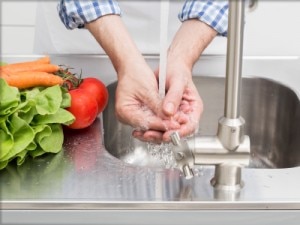You’ve been shopping seasonally, buying only what’s locally available. You’ve taken the trouble to learn where you can find wild fish and which butcher at the farmer’s market offers grass-fed meat and pastured chicken. Now that you’re home and unpacking what you’ve gathered, there are a few key steps to follow in terms of food safety to make sure that, before the magic happens with the seasonings and developing flavors, you’re not going to run into any unfavorable additions, like bacteria or mold.

Wash your hands often. While it may seem a silly thing to say, this simple reminder to make sure you keep your hands clean, especially after handling raw meat, fish or poultry, is quite likely the single most important thing you can do in terms of good kitchen hygiene.
Don’t use sponges. Use a washcloth that you change several times throughout the day. We’ve all seen those old, stinky sponges that are nothing more than a breeding ground for bacteria. Stick with clean, cotton cloths instead.
Use separate cutting boards for produce versus raw meats. The latter should be made of a material such as BPA-free plastic so that it can be disinfected in the dishwasher.
Clean your work surfaces often. A simple mixture of 25 drops each lavender and tea tree oil mixed with a 16-ounce spray bottle filled with distilled water can be used as a daily cleaning agent, while diluted hydrogen peroxide or bleach combined with water are quite effective at disinfecting.
Work in order. Handle produce, especially that which will be served raw, prior to handling meat, fish and poultry.
Keep proteins refrigerated until slightly before cook time. For example, take out the four grass-fed NY Strip steaks about 30 minutes before grilling them; putting meat on the grill that is too cold will prevent even cooking.
Remember 160. 160 degrees F is the minimum temperature you’ll want poultry as well as any fish which is not sashimi grade to reach before eating. Don’t forget to factor in rest time. Removing the protein from the oven at 150 degrees F and then tenting it to allow some of the juices that escaped during cooking to find their way back into the meat will also allow enough time for the minimum temp to be reached. Other proteins may be cooked to a lower temperature, based on one’s desired level of doneness.
Making these steps part and parcel as your every day time in the kitchen will allow you the peace of mind that you’ve done everything you needed to in order to present a lovely meal that smells delicious, tastes exceptionally and isn’t putting anyone at risk!

